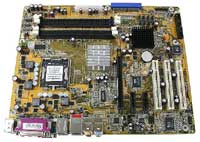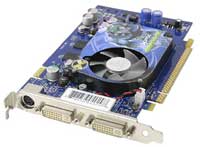Gaming Buyer's Guide - November 2004
by Jarred Walton on November 21, 2004 5:54 PM EST- Posted in
- Guides
Intel Budget Gaming System
At the lowest end of the spectrum, AMD doesn't have quite as much of an advantage in performance over Intel, since the CPU is less of a bottleneck, and there is one item that Intel can offer which AMD cannot (yet): PCI Express. Suffice it to say that especially for die-hard Intel fans, they are not a terrible choice, although they do cost slightly more. Here is our best attempt at matching the Budget AMD system's price and performance.| Budget Intel Pentium 4 System | ||
| Hardware | Recommended Component | Price |
| Processor | Pentium 4 520 2.8 GHz 1MB Cache | 158 |
| Motherboard | DFI 915P-TAG i915P | 118 |
| Memory | 1x512MB Mushkin Basic 2.5-4-4 | 75 |
| Video Card | XFX GeFORCE 6600GT 128 MB | 178 |
| Hard Drive | Seagate Barracuda 80GB EIDE model 7200.7 | 59 |
| Optical Drive | NEC DVD+/-RW Drive Model 3500A | 72 |
| Case and Power Supply | Athenatech A602 Black/Silver with 350W PSU | 62 |
| Display | Samsung 793DF 17 Black/Silver CRT (1280x1024@75 Hz) | 139 |
| Speakers | Logitech Z-640 5.1 | 52 |
| Keyboard and Mouse | Logitech Optical Desktop Combo | 26 |
| Bottom Line | 939 | |
 Click to enlarge. |
 Click to enlarge. |
Another drawback is that dual-channel RAM helps the Pentium 4 more than it does the Athlon 64, so using only one DIMM is going to cut into that performance boost a bit. If you plan on adding 512MB of RAM in the near future, that's not too big of a problem. Otherwise - and we hesitate to say this as they may not be of much use in future systems - using two 256 MB DIMMs will cost about the same as a single 512 MB DIMM. The extra $70 or so spent on an Intel system could be put into other items like a better graphics card or a faster CPU, and AMD also has the 64-bit factor to consider. This is why we still give AMD our primary recommendation, but it really is a close match-up in this price bracket.
Besides shipping PCI Express support, Intel also has their HyperThreading feature, which can help in certain multi-tasking applications. We have not yet seen any performance benefit to HyperThreading in the gaming realm - quite the reverse, in fact, as most games run a few percent slower with HTT enabled - but that could change in the future. With both AMD and Intel shifting away from increasing clock speeds to multi-core designs, it would make sense that games at some point will need to shift to a multi-threaded programming environment in order to extract the most performance from the processor. HTT ends up being nothing that we are overly concerned with as far as games go, but it's still there and it could come into play in the next year or two.
If you feel that our budget recommendations are almost impractical, just take that as an indication of the difficulty of selecting parts for this price segment. These three platforms are all very capable, however, and none of them is truly a bad choice. If you're the type of person who upgrades parts frequently - i.e. more than twice a year - over the life of your system, the socket 939 and socket 775 platforms will be a better choice. From a pure price standpoint, socket 754 still wins out.










70 Comments
View All Comments
spartacvs - Wednesday, January 5, 2005 - link
I decided to wait and I'll most probably go for nforce4. One thing I reallly like about your guide is the fact that there is many budgets. Most of the guides provides 3 systems (budget, price/performance and power) but more systems is really helpfull.Careless Joe - Tuesday, January 4, 2005 - link
RE: the "Cheap" psu in the budget case. Its a re-badged fortron. Very reliable.JarredWalton - Saturday, December 4, 2004 - link
Just FYI, I recently upgraded from the integrated audio on my MSI K8N Neo Platinum to an Audigy 2 ZS. My benchmarks in Half-Life 2 (using a measley 9800 Pro) went up a whopping 1 FPS. It might matter more with a faster GPU, but for my setup the sound card didn't matter much. It did, however, eliminate some static/noise from the audio. I couldn't hear it on the speakers, but on headphones it was very noticeable.Was it worth $75? That depends on how much disposable income you have and how annoying any extra static is. Since I often use headphones on my PC at night (no need to wake the wife and neighbors), it was annoying enough for me that I went and spent the money. For most people - particularly those using moderate to cheap speakers - you probably wouldn't notice.
SDA - Saturday, December 4, 2004 - link
Jarred, very true.. I've seen people defend PowerStream purchases after being told that they're the same as Tagans (which I don't do, by the way; I hate to even implicitly insult something that someone else owns) by saying that OCZ is a good name and is better-recognized, as if that really has anything to do with PSU performance. If you ask me, I don't think that sort of thing should really be factored into recommendations.. if someone wants to pay more for a brand name (when it has been demonstrated that there's no functional advantage), they're probably in the minority. (If someone wants to pay more for the PowerStream's looks, they need 20ccs of taste, stat. .. kidding, PowerStream owners ;)Oh, and spartacvs, just remember that integrated audio (non-SoundStorm integrated audio, anyway) will eat more CPU than a dedicated sound card will. It's not much of a big deal with today's overpowered PCs, if you ask me, and you still get plenty of bang for your buck (infinite bang for your buck, actually, since integrated audio is free).
spartacvs - Friday, December 3, 2004 - link
JarredWalton, yes, I think I understand your argument: AGPat the end of his life and PCIe is comming in.I had bad information about integrated audio. Integrated audio is not fantastic but I'm sure it'll be a majhor improvment over my old sb live!value 4.1... And, as I said, it's a way to save a few dollars. Something I, unfortunately, have to be very cautious these days :(
Thank you very much for your wise comments.
JarredWalton - Friday, December 3, 2004 - link
SDA - I understand that the internals are the same. For some people, however, the outside (and the brand) will matter. It doesn't bother me much, but convincing others of this is more difficult to do. I always prefer the weight test for PSUs (assuming you're at a store where you can pick up the PSU). All things being apparently equal, always go with the heavier PSU. :)Spartacvs - *all* motherboards include integrated audio these days. What Nforce4 doesn't include is the SoundStorm audio that was in Nforce1 and Nforce2 (certain models). NVIDIA is supposed to be working on a high-definition audio solution, but when that will actually arrive is a little difficult to say. The audio that will be on Nforce4 is the same as what is on most Nforce3 boards these days, so don't worry too much about that. If audio is really important to you, pick up a Creative Audigy 2 ZS (for games) or the M-Audio Revolution 7.1 (for more serious audio work).
SDA - Friday, December 3, 2004 - link
That depends on your definition of close, Jarred ;) The only real differences between them are cosmetic (shell, sticker, brand). The components, layout, and design are nearly identical.If you're having trouble with this concept, here's a parallel for you: Alienware's older notebooks (before they switched to Uniwill) and equivalent Sager notebooks (with a comparable configuration, obviously). Same platform, same layouts, same chassis, same components (possible that they used different brands of memory or something, but that's about it), same party assembling them; the differences are almost entirely cosmetic, and the ones that aren't don't apply to functionality.
Hopefully this is all a little clearer now, the world of computer hardware is really far too convoluted for its own good..
spartacvs - Thursday, December 2, 2004 - link
Ok, thanks for you answer. The place I want to buy have most of the memory brands. It's just muskin, they have only a few models.As for the MB. What I don't like about nforce4 is the lack of integrated audio. It increase the price tag a little bit more and I'm tight on money :(
JarredWalton - Thursday, December 2, 2004 - link
SDA - Just pointing out that they're not identical. Close, perhaps, and which you like more is probably more a matter of preference, but they certainly aren't identical.Spartcvs - Corsair, GEIL, Kingston, OCZ, and quite a few others are decent RAM. For value RAM, Kingston and Corsair are probably the most widely spread, but I don't really know what other countries are like in terms of availability. The difference between the motherboards is more difficult to quantify. I really like Abit boards, but I'm not as keen on the VIA chipset - NVIDIA just seems more stable in my experience. Either one is still a fine motherboard, and there are several other socket 939 NForce3 250 boards available. Now, though, waiting for NForce4 non-SLI might be a good idea - get one of those for ~$130 and get a 6600GT PCIe card.
spartacvs - Thursday, December 2, 2004 - link
Hey guys, I have a few questions.Fisrt, I do not overclock my system and will most probaly go with the Antec 2650 case because it's smaller and still a good case. Will also take the 120 GB HD because 160 is overkill for me (hey I hardly fullfill my actual 40 GB).
I hesitate between the abit board and the msi one. What do I lose going for the abit rather than the msi? The Abit is a via chipset, right?
Where I want to buy they don't have much of the mushkin memory. Can you recommand another brand (and model please because there is so many type of memory modules, it's easy to be lost).
Thanks